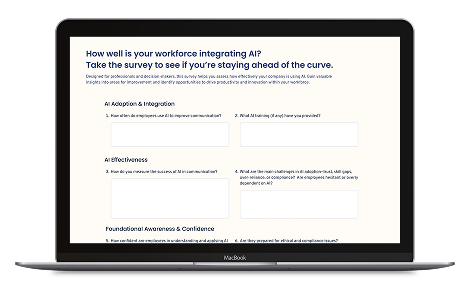WD Communications

If you are in HR, or Talent Management, or are a manager yourself, surely you’ve noticed a trend in traditional press and in social media about the imminent dismantling of traditional performance management processes in large corporations.
Every day it seems another article surfaces about how ratings demotivate, how there are better ways to track performance than traditional annual reviews, and how the Millennials who are shaking the shackles of hierarchical business structures are disinterested—and downright depressed—by performance management.
What’s fascinating in most of these articles is how little time any of them spend on what we’ve seen as the real problem behind the performance management process in most organizations: namely, employees and managers are not often instructed on how to properly document performance. After all, it’s pretty easy to get clicks from readers looking to confirm “Why Annual Reviews Don’t Work.” It’s a more difficult task to actually explain what does work.
Done well, performance documentation and discussions can reveal incredible insights into true human performance and talent management. Done well, performance documentation can actually build transparent expectations and working relationships. Done well, performance documentation can create a telling story of what high performers actually do to be successful. Done well, performance documentation leads naturally to a specific, verifiable rating of performance against expectation.
And finally, done well, performance documentation and discussions can address something that most managers face often, but none of the articles delve too deeply in: addressing actual performance events.
Depressingly, it’s not often done well.
For much of the past 16 years, I’ve gone into organizations and evaluated performance management processes. Like most of us, I didn’t plan to make this my career focus, but sometimes a career focus finds you. In the beginning, companies familiar with our work in enhancing business and technical writing would casually say, “what you really should look at is our performance documents—those are the toughest to write.” And so we did. But what we found was more than a simple documentation problem. It was a process problem, a goal-setting problem, and an assessment problem.
What I see across industries is that most people don’t really mind the PM process provided it’s simple, intuitive, and flexible. What they absolutely hate is being asked to create ratings on a distribution curve that doesn’t make sense, to enter comments and ratings too early, and to carry out a process they are not trained or given time to do properly.
Below are four mistakes that I’ve seen over and over and over, from industry to industry, large company to small. And the nice thing is, these are mistakes that are easily remedied.
To be clear: performance management is changing (this is nothing new), and your company’s system will not be immune to those changes; however, those types of shifts tend to take time. So if the dismantling of your performance documentation and ratings system isn’t coming in the next year, try to get these things corrected right away.
1. You teach employees and managers what to do, where to do it, and when to do it, but you leave the “how” to them. The hardest part of performance management, and performance documentation in particular, is how to create the comments. It’s by far the most common question I get: “What does good look like?”
Most managers and individual contributors fall back on vague, conversational language when describing performance accomplishments because that’s what they’ve always seen. “I work well on teams and keep a positive attitude . . .” “James needs to work on his timeliness around expense reporting,” “Ming is wonderful to work with and often receives positive feedback from customers and co-workers alike.”
All these typical, trite comments have roots in actual performance, but because there’s been no skill building around how to accurately write specific performance comments tied to results, there is no action plan for change and no consistency.
If HR, managers, and employees alike stick to the simple formula, “action verb + performance task + department benefit,” comments will be simple, straight-forward, and event focused. What did the employee specifically do or not do? What impact did that event have on the organization? That’s it.
If you “catch” employees doing things right, and address that positive performance specifically, performers are much more likely to hear that feedback and the occasional specifics you have to give around their poor performance as well.
Unfortunately, managers often get caught up in trying to subjectively assess what performance events mean rather than commenting on them directly. And employees have never seen this type of direct performance assessment, so they are constantly trying to decipher the meaning between the lines.
As Julie Staudenmier, Executive Director of Leadership and Organization Development at Boehringer Ingelheim says, “Documenting if done right, takes away some of the natural tendencies that people have to resisting honest discussions about how employees are doing. If we introduce discipline around the skill, we help people understand the necessity of the documentation process. It’s a system that encourages reflection on performance of all employees, not just high or low performers.”
Among the managers I work with, addressing poor performance in writing is the most difficult task to master. Underscoring accountability here is huge. Managers must understand that “softening the blow” when documenting performance rarely leads to behavior change. In fact, usually it leads to confusion and even worse performance. You don’t have to be punitive to address poor performance. We bring managers back to the simple task of determining performance against goal using “did” or “did not.”
And of course, the trick is to document the exact performance events that are occurring. If you “catch” employees doing things right, and address that positive performance specifically, performers are much more likely to hear that feedback and the occasional specifics you have to give around their poor performance as well.
This simple approach should lead not only the documentation process, but also manager-employee discussions about performance status versus expectation.
2. Your system “locks” too early. The biggest complaint we hear: “But my goals constantly change . . . ” Yep, welcome to corporate life in 2020. Make sure your system and process allows for the ability to change goals as priorities change. This flexible goal- and performance-tracking approach is critical as virtual work grows and companies flex and change in the current “gig-based” business climate.
We commonly recommend employees and managers have a set meeting to make sure goals are still tracking actual initiatives at least once a month. If goals or metrics need updating, agree to changes and establish the new expectation. Then move forward. Expect priority shifts and have a plan for capturing them.
We commonly recommend employees and managers have a set meeting to make sure goals are still tracking actual initiatives at least once a month.
Greg Wells, who has been intimately involved in performance management processes at two large insurance firms and is currently Director of Customer Service and Claims at Prudential Insurance says, “We document a lot. We do monthly scorecards and weekly check-ins in addition to the standard mid-year and annual reviews. I’ve been managing for 31 years in the industry, and it doesn’t have to be as hard as people make it. Take two minutes a day to track your own performance and the performance of your direct reports, and you’ll excel.”
3. Your ratings are due before the comments are due. This is an easy fix, but it’s shocking to me how often companies ask managers for ratings before requiring them to document the performance that leads to those ratings. Even more alarming is the ratings calibration meeting that includes no sharing of actual documentation; typically, “calibration” is just a manager-by-manager presentation of why each employee deserves the rating he or she is being assigned.
Here’s the thing: you can still require ratings in mid-December (or even earlier) so you can start your calibration and compensation processes, but just make sure those ratings come with attached performance documentation that supports those ratings. Obviously, ratings should come from comments, not the other way around.
Jeffrey Giacoponello, AVP Talent Partner at Lincoln Financial Group, points to the need for transparency in the process to create buy-in from employees: “It’s a time consuming process. Companies must ensure that their employees know their comments are being considered in the rating process. Otherwise they will see their efforts as a waste of time.”
Of course, this process takes diligence, training, and proper direction of human resource business partners. As Staudenmier says, “The very best of our HRBPs are doing quality checks so that we can put our measurement where our mouth is and tie real reported performances to our company strategies.”
Wells says that Prudential strives to assist managers in carving time to create documentation that’s meaningful: “Most challenging for most people is finding the time to do things right. I think our managers understand there can be ramifications for both individuals and organizations, and they want to do things well. That takes time. And of course, they are still performing their own busy, challenging roles.”
4. You allow managers to populate employee goals with their own. Let’s just go ahead and tell employees this is a worthless process and even your leaders don’t buy in. Sadly, if companies really queried some of their highest level managers, they’d find that this tendency is fairly rampant.
Most of the companies I work with that do performance management well have a quick goal calibration meeting to start the year. This level-setting allows managers to make sure that they aren’t missing key initiatives in their discussions with their employees. It also helps them ensure that their visualization of employee success is the same as other managers within their divisions. Managers who know their initiatives are aligned and much more likely to be able to assist employees who are creating their own goals. As with any quality initiative, line-of-sight is crucial.
“We seek to help people realize that well-written performance documentation can help people understand if they are in the right roles, are doing their jobs well, or need additional skills to meet expectations,” Wells says.
In the end, effective performance management and documentation is the simple record of expected versus actual. As Staudenmier says, “It’s still the best way to connect people to what we are here for.”
Mike Mannon is the President and CEO of WD Communications, a global communication skills training firm located in Howell, NJ. Mike is a speaker and consultant specializing in performance management and effective leadership.
www.wdcommunications.com
Take the survey to see if you’re staying ahead of the curve.
Take the Survey